Interesting Facts About Eyes You Never Knew
Your eyes are more complex than you might realize. Did you know your cornea lacks blood vessels and relies on diffusion for nutrients? It's also incredibly sensitive, with over 200,000 nerve endings. Your retina contains about 120 million rod cells and 6 million cone cells, allowing you to perceive roughly 10 million colors. Curiously, dolphins sleep with one eye open, utilizing unihemispheric slow-wave sleep to remain alert. Owls have tube-shaped eyes that can't move, but they can rotate their heads up to 270 degrees for a broad view. These are just a few intriguing facts about eyes; there's much more to uncover about these remarkable organs.
This post may contain affiliate links. If you make a purchase through these links, I may earn a commission at no additional cost to you. Additionally, portions of this post may be generated using artificial intelligence (AI) technology. While we strive for accuracy, please be aware that AI-generated content may not always be perfect and should be fact-checked when necessary.
The Spatula Scoops
- The cornea has no blood vessels and relies on diffusion for nutrients, yet contains over 200,000 nerve endings.
- Human eyes can perceive approximately 10 million colors through three types of cone cells.
- Blue eyes appeared only around 6,000 years ago and are considered a recessive trait.
- The brain automatically fills in blind spots using information from the other eye and surroundings.
- Dolphins sleep with one brain hemisphere awake, allowing them to remain vigilant and surface for air.
Eye Color Genetics
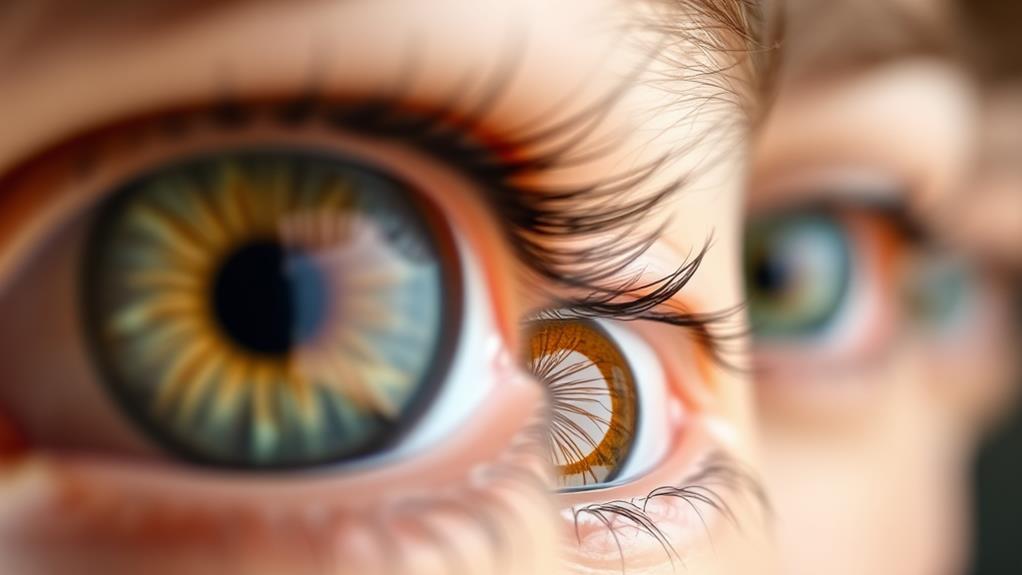
For centuries, eye color has fascinated scientists and the general public alike. The intricate world of eye color genetics reveals surprising complexities that you might not expect. Did you know that brown eyes are the most common globally, accounting for 70-79% of the population? In contrast, blue and green eyes are recessive traits, with blue eyes only emerging about 6,000 years ago.
You might be surprised to learn that green eyes are incredibly rare, present in only 2% of people worldwide. This scarcity highlights the unique interplay of genetic factors determining eye color. Even more intriguing is that brown-eyed parents can have children with blue or green eyes, showcasing the hidden genetic diversity within families.
Eye color genetics also explain phenomena like albinism, a condition where minimal iris pigmentation can result in red or pink eyes. This rare occurrence underscores the role of melanin in determining eye color. Understanding these genetic intricacies not only satisfies curiosity but also aids in medical research and genetic counseling. As you explore deeper into eye color genetics, you'll discover a fascinating world where science and heredity intersect, revealing the beautiful diversity of human eyes.
Dolphin Sleep Patterns

Dolphins exhibit one of nature's most fascinating sleep adaptations. You might be surprised to learn that these intelligent marine mammals have developed a unique sleep pattern called unihemispheric slow-wave sleep. This remarkable ability allows dolphins to rest one hemisphere of their brain while keeping the other active, ensuring their survival in the ocean.
During this sleep state, you'd notice that a dolphin keeps one eye open, maintaining environmental awareness and vigilance against potential predators. This adaptation is essential for their eye health and overall well-being. While half their brain rests, dolphins can continue swimming and surfacing for air, showcasing their impressive multitasking abilities.
You might wonder how long dolphins sleep. They typically get about 8 hours of sleep daily, but it's not continuous like human sleep. Instead, their rest is fragmented into short episodes throughout a 24-hour period. This sleep pattern allows dolphins to balance their need for rest with the demands of their aquatic lifestyle. By employing this unique sleep strategy, dolphins can effectively navigate their environment, evade dangers, and maintain their vision and overall eye health in the challenging ocean ecosystem.
Blind Spots and Visual Perception

You might be surprised to learn that your eyes have blind spots, areas where you can't see due to the absence of light-sensitive cells. Your brain, however, is remarkably adept at filling in these gaps using information from your other eye and surrounding visual context. Understanding these blind spots and how your brain compensates for them can enhance your overall visual awareness, potentially helping you avoid accidents in your daily life.
Understanding Our Blind Spots
The intricacy of human vision extends beyond what meets the eye, quite literally. You might be surprised to learn that each of your eyes has a natural blind spot. This area, where the optic nerve exits the retina, lacks photoreceptors, creating a small gap in your visual field. Don't worry, though; you're not missing out on much. The average blind spot is only about 7.5 degrees of your visual field, roughly the size of a quarter held at arm's length.
Your brain is incredibly adept at compensating for these blind spots. It uses information from your other eye and surrounding visual cues to fill in the gaps, resulting in a seamless visual perception. This remarkable feat of neural processing means you're likely unaware of your blind spots in everyday life. Your dual-eye configuration also plays an essential role in this process. While each eye has its own blind spot, the combination of both eyes' input allows you to perceive a complete field of vision without noticeable gaps. This intricate system demonstrates the fascinating ways your brain and eyes work together to enhance your overall visual experience.
Brain's Compensatory Mechanisms
Remarkably, our brains employ sophisticated compensatory mechanisms to overcome the limitations of our eyes' blind spots. Your brain seamlessly fills in the gaps in visual information caused by these blind spots, ensuring you perceive a complete and uninterrupted view of your surroundings. This process happens automatically, without you even being aware of it.
Each of your eyes has a slightly different blind spot, which allows your brain to utilize information from both eyes to create an all-encompassing visual field. By combining and interpreting data from both eyes, your brain constructs a complete picture of your environment. This compensatory mechanism is so effective that most people are unaware they even have blind spots.
Understanding these brain mechanisms can enhance your visual awareness and improve your ability to navigate safely. For instance, being cognizant of your blind spots can help you make more informed decisions when driving or participating in activities that require acute visual perception. By recognizing the brain's role in compensating for these visual limitations, you can develop a deeper appreciation for the complexity of your visual system and its ability to adapt to challenges.
Implications for Visual Awareness
Understanding the implications of blind spots and brain compensation mechanisms can greatly impact your visual awareness. You might be surprised to learn that your eyes have natural blind spots, yet you're likely unaware of them in daily life. This is due to your brain's remarkable ability to process visual information and fill in the gaps seamlessly.
Your visual perception is a complex interplay between your eyes and brain. Each eye has a blind spot where the optic nerve connects to the retina, creating a small gap in your visual field. However, your brain compensates for this by using information from the surrounding areas and the other eye. This process highlights the importance of binocular vision, where both eyes work together to enhance depth perception and overall visual awareness.
The effectiveness of this compensation demonstrates your brain's adaptability. Despite having blind spots that cover about 30 degrees of your visual field in each eye, you experience fluid and uninterrupted vision. This efficient brain processing allows you to navigate the world without constantly noticing gaps in your sight, showcasing the intricate relationship between your eyes and brain in creating a cohesive visual experience.
Evolution of Eye Structure
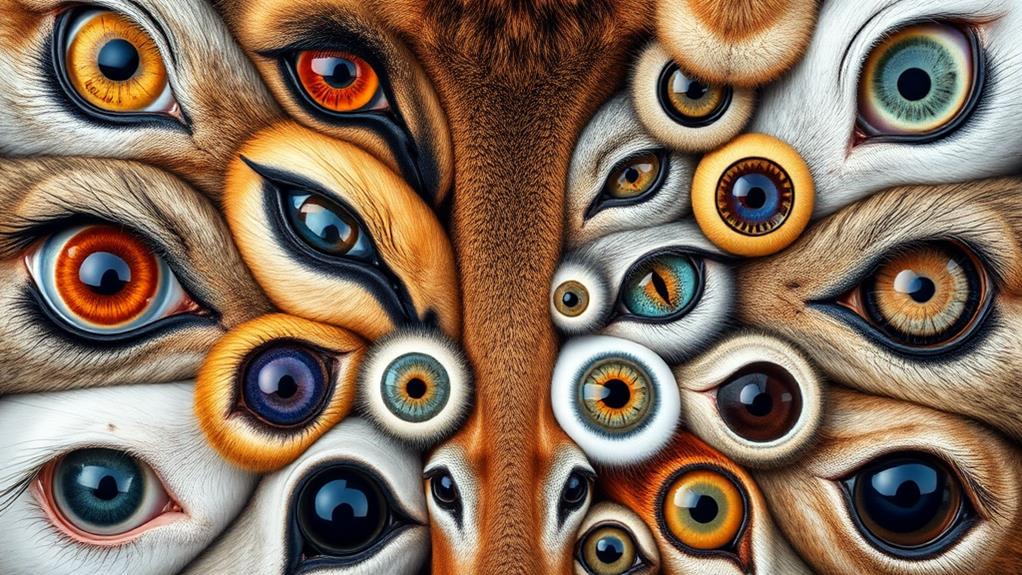
How did our complex, image-forming eyes evolve from simple light-sensitive structures? The evolution of eyes is a fascinating journey spanning over 550 million years. It all began with single-celled organisms developing basic light-sensitive spots, allowing them to detect light and dark. As time passed, these primitive structures gradually became more complex, adapting to various environments and survival needs.
The process of natural selection favored organisms with better vision, leading to the development of more sophisticated eye structures. In vertebrates, you'll find eyes that can form detailed images, distinguish colors, and perceive depth. This complex adaptation didn't happen overnight; it took millions of years of incremental changes.
Different species evolved unique eye structures to suit their specific needs. For example, the box jellyfish has multiple lenses in its eyes, enhancing its ability to detect movement in water. Your own eyes are the result of countless evolutionary adaptations, providing you with features like color vision and depth perception. These adaptations have given humans significant survival advantages throughout our species' history.
Cornea's Unique Characteristics
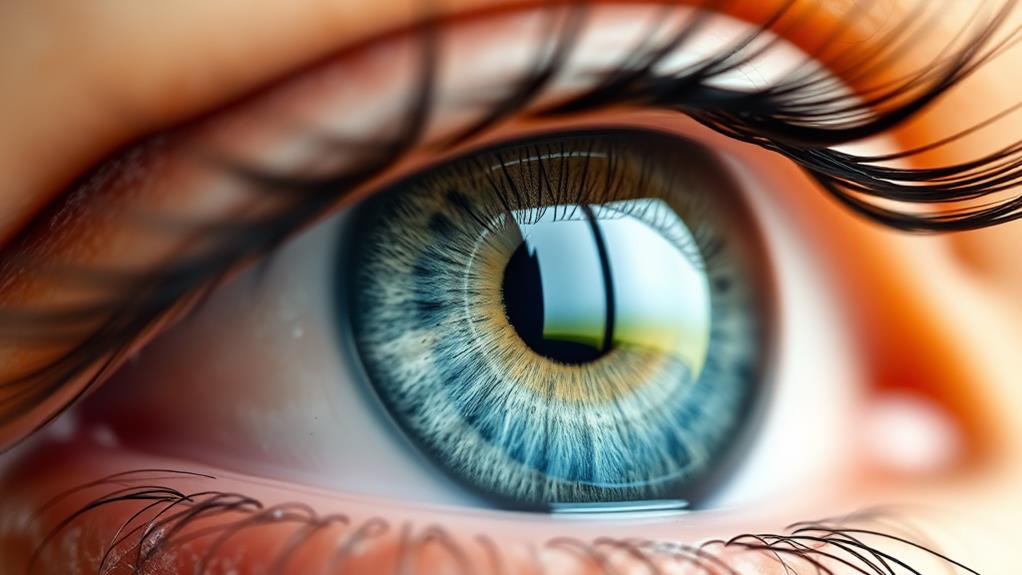
The cornea, a key component in our evolved eyes, boasts several unique characteristics that set it apart from other tissues in the human body. Unlike most tissues, your cornea lacks blood vessels, relying instead on diffusion for its nutrient supply. This absence of blood vessels contributes to its transparency, which is essential for its role in focusing light onto your retina.
You might be surprised to learn that the cornea accounts for about 40% of your eye's total optical power. It's also incredibly sensitive to touch, with over 200,000 nerve endings packed into its structure. This sensitivity helps protect your eyes from potential damage.
Another unique characteristic of your cornea is its ability to heal quickly. Minor scratches can typically recover within 48 hours if you take proper care. However, if you notice any growth of blood vessels in your cornea, it's a sign of poor health and may require medical attention.
Understanding these unique characteristics of your cornea can help you appreciate the complexity of your eyes and the importance of maintaining their health.
Depth Perception Mechanisms

While you navigate the world around you, your brain constantly processes visual information to create a three-dimensional understanding of your environment. This remarkable ability, known as depth perception, relies heavily on a mechanism called stereopsis. Your eyes, positioned slightly apart, capture two slightly different images. Your brain then combines these images, calculating spatial relationships and producing a 3D view of your surroundings.
This binocular vision is essential for your daily activities. When you're driving, playing sports, or simply reaching for an object, you're relying on depth perception to judge distances accurately. But it's not just about having two eyes. Your brain also interprets various visual cues to enhance your depth perception. These include size variations, overlapping objects, and texture gradients, which provide additional context about your environment.
Interestingly, your depth perception is most effective within about 20 feet. Beyond this range, you start relying more on monocular cues, which are depth indicators that work with just one eye. Understanding these mechanisms can help you appreciate the complexity of your visual system and its role in your everyday life.
Eye Protection Reflexes
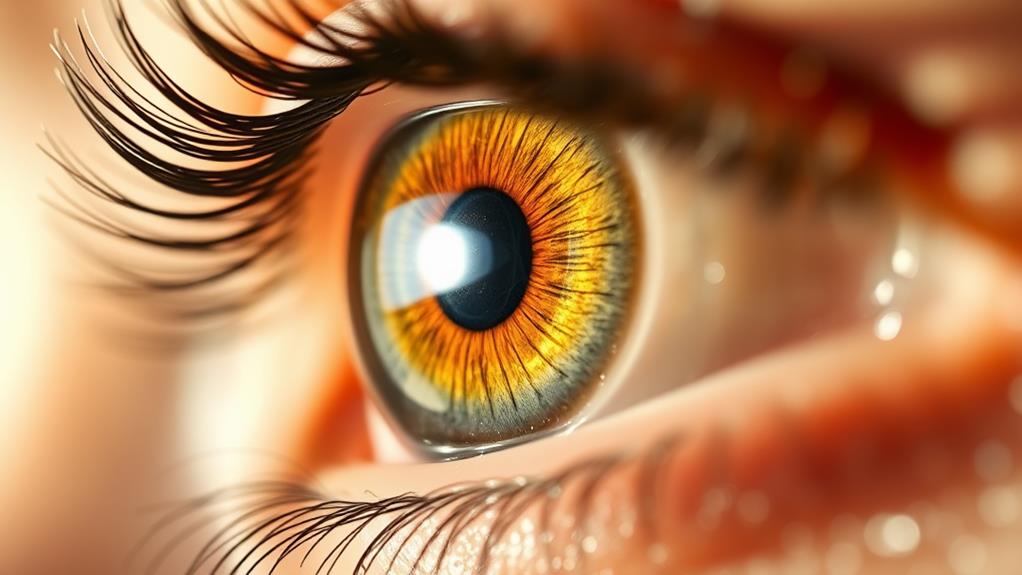
Your eyes have built-in protection mechanisms that spring into action without you even thinking about it. When faced with potential threats, your eyes automatically blink, your pupils constrict to limit light intake, and your tear ducts produce extra moisture to flush out irritants. These reflexes work together to shield your eyes from harm, ensuring that this essential sensory organ remains safe and functional in various situations.
Automatic Blinking Response
Blinking, an often overlooked yet essential function, serves as your eyes' first line of defense against potential threats. This automatic blinking response occurs approximately 15-20 times per minute, with each blink lasting about 1/10th of a second. You might not realize it, but this rapid action is a sophisticated protective mechanism that's evolved over time.
The blink reflex is an involuntary response triggered by potential dangers to your eyes. It happens so quickly that it doesn't disrupt your visual processing, allowing you to maintain a clear view of your surroundings. This evolutionary significance can't be overstated; it safeguards your retina and minimizes the risk of injury from fast-approaching objects.
When you consider that the average person blinks thousands of times a day, you'll appreciate the constant protection your eyes receive. This reflex not only shields your eyes from debris but also helps keep them moistened. By understanding the importance of this automatic response, you can better appreciate the complex systems at work in your body, constantly protecting your vision without conscious effort.
Pupil Constriction Mechanism
The pupil constriction mechanism serves as another essential eye protection reflex, complementing the blinking response. This remarkable process, known as the photopupillary reflex, is your eyes' way of safeguarding against excessive brightness. When you're exposed to bright light, your pupils rapidly constrict, typically within fractions of a second. This swift action is controlled by the parasympathetic nervous system, which activates the sphincter pupillae muscle.
The pupil constriction mechanism offers several benefits:
- Protects your retina from potential damage caused by excessive light
- Enhances your depth of field, improving focus on nearby objects
- Increases the sharpness of your vision in bright conditions
You'll notice that in dim lighting, your pupils dilate to allow more light in, improving your visibility. This continuous adjustment helps maintain ideal vision across various lighting conditions. It's fascinating to reflect on how this reflex operates without your conscious control, constantly working to protect your eyes and enhance your visual experience. Understanding these intricate processes can help you appreciate the complexity of your visual system and the importance of eye care.
Tear Production Defense
Tear production kicks in as another essential eye protection reflex, working alongside blinking and pupil constriction. You might not realize it, but your tears are constantly at work, shielding your eyes from potential harm. They're not just for crying; tears play an important role in maintaining your eye health by cleaning, lubricating, and protecting against irritants.
Interestingly, newborns can't produce tears right away. It takes 6-8 weeks for their tear ducts to develop fully. This means that when babies cry in their first weeks of life, they do so without tears – a fact that might surprise many parents.
Your eyes' defense mechanisms are incredibly sophisticated. For instance, they'll automatically close when faced with fast-approaching dangers, even before you consciously process the threat. This rapid response helps prevent potential injuries to your retina.
| Tear Function | Purpose | Significance |
|---|---|---|
| Lubrication | Reduces friction | Prevents dryness |
| Cleaning | Removes debris | Maintains clarity |
| Protection | Guards against irritants | Safeguards eye health |
| Nourishment | Provides oxygen | Supports corneal health |
Regular tear production is essential for your overall eye health. Without sufficient tears, you may experience dryness and become more susceptible to eye infections.
Light-Sensitive Cell Distribution
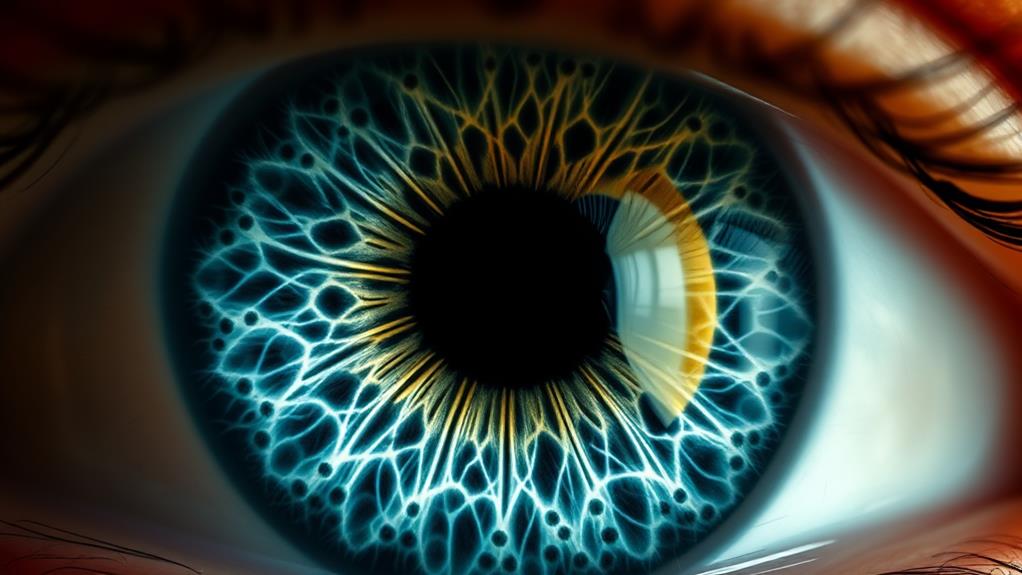
Imagine your eyes as intricate cameras, each equipped with millions of tiny sensors. These sensors are actually light-sensitive cells called rods and cones, distributed across your retina. Your retina contains about 120 million rod cells and 6 million cone cells, each playing a significant role in your visual processing.
Rod cells are densely packed in the peripheral regions of your retina, enhancing your low-light vision and motion detection. Cone cells, on the other hand, are concentrated in the fovea, the central part of your retina, providing sharp and detailed color vision. This distribution allows you to:
- See in dim lighting conditions
- Detect motion effectively, especially in your peripheral vision
- Perceive approximately 10 million colors
The arrangement of these light-sensitive cells is essential for various visual tasks. For instance, the high concentration of rods in your peripheral retina boosts your ability to detect movement, which is key for survival in low-light environments. Meanwhile, the three types of cone cells – sensitive to short (blue), medium (green), and long (red) wavelengths – work together to create your rich color perception.
Owl Vision Adaptations

While humans have impressive visual capabilities, owls have evolved extraordinary adaptations for nocturnal vision. These owl vision adaptations make them masters of the night sky. You'll find that owls' eyes are packed with rod photoreceptors, light-sensitive cells that excel in low-light conditions. This allows them to see clearly when it's dark out, giving them a significant advantage over their prey.
Unlike your eyes, owls have tube-shaped eyes that can't move. To compensate, they can rotate their heads up to 270 degrees, providing an expansive field of view. Their large corneas and pupils let in more light, enhancing their ability to see in darkness. Additionally, owls have a reflective layer called the tapetum lucidum behind their retinas. This layer bounces light back through the retina, increasing sensitivity and improving night vision.
These adaptations don't just help owls see in the dark; they also provide excellent depth perception. This means owls can accurately judge distances when hunting, making them incredibly efficient predators. Their unique eye structure allows them to pinpoint prey with remarkable precision, even in the darkest of nights.
Frequently Asked Questions
What Are 5 Interesting Facts About the Eye?
You'll be amazed to learn that your eyes can distinguish about 10 million colors, thanks to cone cells in your retina. Each of your eyes contains over 2 million moving parts, making them incredibly complex. You blink 15-20 times per minute, protecting and moisturizing your eyes. Remarkably, you can detect a candle flame from 14 miles away on a dark night. Your retina's rod and cone photoreceptors enable both night vision and color recognition, allowing for a vast range of visual perception.
What Are Rare Facts About the Eye?
You might not know that your eyes have some truly remarkable features. Did you know that the pattern of your iris is more unique than your fingerprints? It's true – your iris has 256 distinctive characteristics compared to just 40 in fingerprints. You can also detect a candle flame from up to 14 miles away on a dark night, showcasing your eyes' incredible light sensitivity. Your eyes are quick healers, too, with minor corneal scratches often mending within 48 hours.
What Is Unique to the Eye?
Imagine your eye as a unique fingerprint of light and color. You'll find several remarkable features that set your eyes apart. Your iris boasts 256 distinct characteristics, surpassing even your fingerprints in uniqueness. Your cornea, the only tissue without blood vessels, gets nourishment directly from the air. Your retina's ability to detect just three colors allows you to perceive millions of hues. On a dark night, you can spot a candle flame from an astonishing 14 miles away.
What Do We Not Know About Eyes?
You might be surprised to learn that there's still much we don't know about eyes. Scientists are still studying how the brain processes visual information and how certain eye diseases develop. We're unsure about the full extent of blue light's long-term effects on eye health. The exact mechanisms behind color perception in different lighting conditions remain a mystery. Additionally, researchers are still investigating how to regenerate damaged eye tissues and restore vision in cases of blindness.





